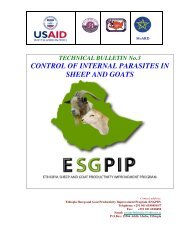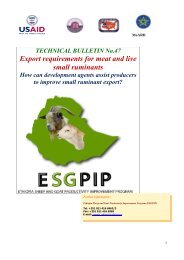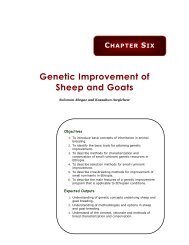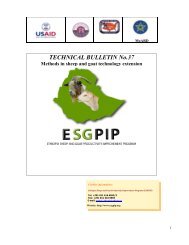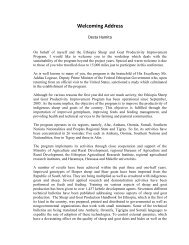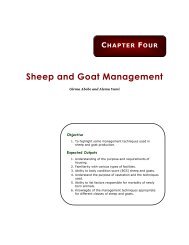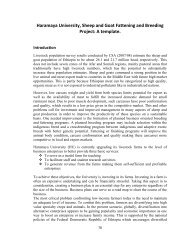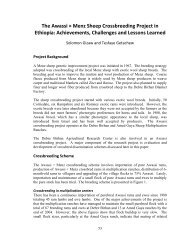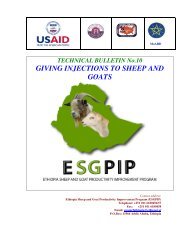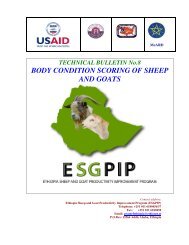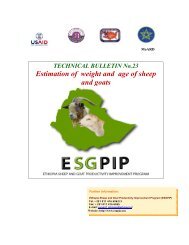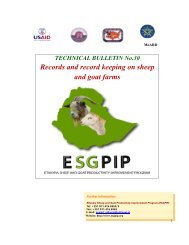Economic Significance of Sheep and Goats - esgpip
Economic Significance of Sheep and Goats - esgpip
Economic Significance of Sheep and Goats - esgpip
You also want an ePaper? Increase the reach of your titles
YUMPU automatically turns print PDFs into web optimized ePapers that Google loves.
CHAPTER ONE<br />
<strong>Economic</strong> <strong>Significance</strong> <strong>of</strong><br />
<strong>Sheep</strong> <strong>and</strong> <strong>Goats</strong><br />
Adane Hirpa <strong>and</strong> Girma Abebe<br />
Objectives<br />
1. To explain the importance <strong>of</strong> sheep <strong>and</strong> goats in rural<br />
production systems.<br />
2. To show the advantages <strong>of</strong> small ruminants over cattle.<br />
3. To show the trends in export for sheep <strong>and</strong> goat meat<br />
<strong>and</strong> how that impacts dem<strong>and</strong> <strong>and</strong> production.<br />
4. To discuss the constraints <strong>of</strong> sheep <strong>and</strong> goat production<br />
in Ethiopia.<br />
Expected Outputs<br />
1. Improved knowledge <strong>of</strong> the economic significance <strong>and</strong><br />
roles <strong>of</strong> sheep <strong>and</strong> goats in the livelihoods <strong>of</strong> producers<br />
in Ethiopia.<br />
2. Increased underst<strong>and</strong>ing <strong>of</strong> the constraints <strong>of</strong> sheep<br />
<strong>and</strong> goat production in Ethiopia.
2<br />
A D A N E A N D G I R M A<br />
1.1. <strong>Significance</strong> (Advantages) <strong>of</strong> Raising <strong>Sheep</strong> <strong>and</strong> <strong>Goats</strong><br />
The total number <strong>of</strong> sheep <strong>and</strong> goats in Ethiopia is estimated to be nearly 48 million. <strong>Sheep</strong> <strong>and</strong> goats are<br />
widely adapted to different climates <strong>and</strong> are found in all production systems. They also have lower feed<br />
requirements compared to cattle because <strong>of</strong> their small body size. This allows easy integration <strong>of</strong> small<br />
ruminants into different farming systems.<br />
Human population growth in Ethiopia is forcing the conversion <strong>of</strong> many former grazing areas into cropl<strong>and</strong>s<br />
needed for increased food production. Raising large ruminants is becoming increasingly difficult as a result<br />
<strong>of</strong> the ensuing lack <strong>of</strong> grazing areas. L<strong>and</strong> holdings in densely populated areas are below 0.5 ha. In such<br />
places, the importance <strong>of</strong> sheep <strong>and</strong> goats in fulfilling the role once played by cattle for meat, milk <strong>and</strong><br />
manure production is being increasingly recognized. The increased dem<strong>and</strong> for sheep <strong>and</strong> goat meat has also<br />
increased their importance in lowl<strong>and</strong> pastoral areas as a source <strong>of</strong> cash income, food security, etc.<br />
Special features <strong>of</strong> sheep <strong>and</strong> goats<br />
Feeding behavior<br />
<strong>Sheep</strong> <strong>and</strong> goats have different but complementary feeding habits. <strong>Sheep</strong> are grazers <strong>and</strong> amenable to<br />
herding, hence a species <strong>of</strong> choice in mixed cropping areas where cereal production dominates. On the other<br />
h<strong>and</strong>, goats are browsers <strong>and</strong> highly selective feeders – a strategy that enables them to thrive <strong>and</strong> produce<br />
even when feed resources, except bushes <strong>and</strong> shrubs, appear to be non-existent. Thus, the presence <strong>of</strong> goats<br />
in mixed species grazing systems can lead to a more efficient use <strong>of</strong> the natural resource base <strong>and</strong> add<br />
flexibility to the management <strong>of</strong> livestock. This characteristic is especially desirable in fragile environments.<br />
Size<br />
Being small-sized animals, sheep <strong>and</strong> goats require a small initial investment. Their small size, together with<br />
early maturity, makes them suitable for meeting subsistence needs for meat <strong>and</strong> milk.<br />
Fat deposition<br />
<strong>Sheep</strong> <strong>and</strong> goats vary in fat deposition, presumably due to different adaptation strategies. Compared to goats,<br />
sheep lay down more subcutaneous <strong>and</strong> intramuscular fat from surplus energy. <strong>Goats</strong> tend to lay down more<br />
internal fat, which is not associated with the carcass. Where carcass fat is a delicacy <strong>and</strong> fetches a higher<br />
price, sheep make an important contribution to the household economy.<br />
Survival rate during drought<br />
<strong>Sheep</strong> <strong>and</strong> goats have higher survival rates under drought conditions compared to cattle. Moreover, because<br />
<strong>of</strong> their reproductive rates, flock numbers can be restored more rapidly. With regard to goats, water economy<br />
is also an important biological feature. It is common for goats to be watered every four days <strong>and</strong> still provide<br />
a reasonable amount <strong>of</strong> production.<br />
High <strong>of</strong>ftake<br />
Due to their short reproductive cycles (short lambing/kidding interval) <strong>and</strong> high incidence <strong>of</strong> multiple births<br />
(particularly for some breeds such as the Horro), there is potential for a higher annual <strong>of</strong>ftake <strong>of</strong> sheep <strong>and</strong><br />
goats than seen with cattle. This allows farmers/producers a quick interval <strong>of</strong> selling part <strong>of</strong> their flock <strong>and</strong><br />
generating cash income.<br />
Ethiopia <strong>Sheep</strong> <strong>and</strong> Goat Productivity Improvement Program
E C O N O M I C S I G N I F I C A N C E<br />
3<br />
1.2. The Role <strong>of</strong> <strong>Sheep</strong> <strong>and</strong> <strong>Goats</strong> in Food <strong>and</strong> <strong>Economic</strong> Security<br />
<strong>Sheep</strong> <strong>and</strong> goats are among the major economically important livestock in Ethiopia. There are about 23.62<br />
million sheep <strong>and</strong> 23.33 million goats (IBC, 2004) in the country, playing an important role in the livelihood<br />
<strong>of</strong> resource-poor farmers. They provide their owners with a vast range <strong>of</strong> products <strong>and</strong> services such as meat,<br />
milk, skin, hair, horns, bones, manure <strong>and</strong> urine for cash, security, gifts, religious rituals, medicine, etc.<br />
<strong>Sheep</strong> <strong>and</strong> goats are relatively cheap <strong>and</strong> are <strong>of</strong>ten the first asset acquired, through purchase or customary<br />
means, by a young family or by a poor family recovering from a disaster such as drought or war. <strong>Sheep</strong> <strong>and</strong><br />
goats, once acquired, become a valuable asset providing security to the family as well as milk <strong>and</strong> dairy<br />
products.<br />
In the subsistence sector, farmers <strong>and</strong> pastoralists depend on small ruminants for much <strong>of</strong> their livelihood,<br />
<strong>of</strong>ten to a greater extent than on cattle, because sheep <strong>and</strong> goats are generally owned by the poorer sectors <strong>of</strong><br />
the community. Any intervention that improves the productivity <strong>of</strong> sheep <strong>and</strong> goats is important in creating<br />
wealth <strong>and</strong> improving the st<strong>and</strong>ard <strong>of</strong> living <strong>of</strong> resource-poor farmers. The short generation interval <strong>of</strong> sheep<br />
<strong>and</strong> goats coupled with high frequency <strong>of</strong> multiple births allow for rapid increases in animal numbers. This<br />
builds financial capital <strong>and</strong> allows the sale <strong>of</strong> surplus animals for cash that can be used for other agricultural<br />
enterprises, school fees, medical bills, etc.<br />
Very <strong>of</strong>ten, there are no banking facilities in rural areas <strong>and</strong> an easy way to store cash for future needs is<br />
through the purchase <strong>of</strong> sheep <strong>and</strong> goats. In fact, in some areas, small ruminants have been described as the<br />
‘village bank’. It has to be noted that this is beyond the cash value <strong>of</strong> the animal. Small ruminants represent<br />
only 7% <strong>of</strong> the average total capital invested in livestock in the mixed crop-livestock production system, but<br />
they account on average for 40% <strong>of</strong> the cash income <strong>and</strong> 19% <strong>of</strong> the total value <strong>of</strong> subsistence food derived<br />
from all livestock production.<br />
<strong>Sheep</strong> <strong>and</strong> goats contribute a quarter <strong>of</strong> the domestic meat consumption; about half <strong>of</strong> the domestic wool<br />
requirements; about 40% <strong>of</strong> fresh skins <strong>and</strong> 92% <strong>of</strong> the value <strong>of</strong> semi-processed skin <strong>and</strong> hide export trade. It<br />
is estimated that 1,078,000 sheep <strong>and</strong> 1,128,000 goats are used in Ethiopia for domestic consumption<br />
annually. There is also a growing export market for sheep <strong>and</strong> goat meat in the Middle Eastern Gulf States<br />
<strong>and</strong> some African countries (Figure 1.1). At optimum <strong>of</strong>ftake rates, Ethiopia can export 700,000 sheep <strong>and</strong> 2<br />
million goats annually, <strong>and</strong> at the same time supply 1,078,000 sheep <strong>and</strong> 1,128,000 goats for the domestic<br />
market. The current annual <strong>of</strong>ftake rate <strong>of</strong> sheep <strong>and</strong> goats is, however, only 33 <strong>and</strong> 35%, respectively. The<br />
average carcass weight <strong>of</strong> Ethiopian sheep <strong>and</strong> goats is 10 kg, which is the second lowest in sub-Saharan<br />
Africa.<br />
The increased domestic <strong>and</strong> international dem<strong>and</strong> for Ethiopian sheep <strong>and</strong> goats has established them as<br />
important sources <strong>of</strong> inl<strong>and</strong> revenue as well as foreign currency. This increased dem<strong>and</strong> also creates an<br />
opportunity to substantially improve food security <strong>of</strong> the population <strong>and</strong> alleviate poverty.<br />
Small Ruminant Meat Exports<br />
7000<br />
6000<br />
Metric Tons<br />
5000<br />
4000<br />
3000<br />
2000<br />
Mutton, Lamb<br />
Goat meat<br />
Total<br />
1000<br />
0<br />
1993<br />
1994<br />
1995<br />
1996<br />
1997<br />
1998<br />
1999<br />
2000<br />
2001<br />
2002<br />
2003<br />
2004<br />
Figure 1.1. Volume (Metric Tons) <strong>of</strong> small ruminant meat exports from Ethiopia, 1993–2004.<br />
Source: Data for 1993–2003 (FAO statistics); Data for 2004 (Ethiopian LFMD, unpublished statistics).<br />
<strong>Sheep</strong> <strong>and</strong> Goat Production H<strong>and</strong>book for Ethiopia
4<br />
A D A N E A N D G I R M A<br />
1.3. Major Constraints <strong>of</strong> <strong>Sheep</strong> <strong>and</strong> Goat Production in Ethiopia<br />
<strong>Sheep</strong> <strong>and</strong> goat production <strong>and</strong> productivity in Ethiopia is constrained by many factors. The major ones are<br />
summarized below.<br />
Scarcity <strong>of</strong> feed: The feed resource base for sheep <strong>and</strong> goat production in Ethiopia is natural grazing <strong>and</strong><br />
crop residues. The quality <strong>and</strong> supply <strong>of</strong> these resources is seasonally variable. Grazing resources in the<br />
highl<strong>and</strong>s are diminishing due to increases in cropping l<strong>and</strong>. Bush encroachment <strong>and</strong> overgrazing have<br />
reduced grazing resources in the pastoral areas.<br />
Lack <strong>of</strong> infrastructure: Infrastructure necessary to transport livestock or livestock products from remote<br />
rural communities, where production is concentrated, to urban markets is lacking. <strong>Sheep</strong> <strong>and</strong> goats are<br />
generally trekked long distances for marketing, <strong>of</strong>ten without adequate water <strong>and</strong> feed. They are also trekked<br />
similarly long distances in search <strong>of</strong> feed <strong>and</strong> water. There are very limited market centers <strong>and</strong> stock routes<br />
with the necessary facilities such as feeding <strong>and</strong> watering points.<br />
High mortality rates: About one-half <strong>of</strong> all lambs/kids born die due to various causes. This is a very<br />
important constraint limiting productivity. Annual mortality in all classes <strong>of</strong> stock averages 23% for sheep<br />
<strong>and</strong> 25% for goats in the central highl<strong>and</strong>s.<br />
Inadequate veterinary coverage: This results in high mortality <strong>and</strong> morbidity. Certain disease conditions<br />
are also causing Ethiopian animals <strong>and</strong> products to be banned from export markets.<br />
Long marketing channels <strong>and</strong> lack <strong>of</strong> market information: Producers do not have access to market<br />
information. The system lacks market orientation, which would have been an important driving force for<br />
increased production.<br />
Low product quality: Poor quality <strong>of</strong> live animals <strong>and</strong> small ruminant meat <strong>and</strong> meat products prevents<br />
penetration into many export markets.<br />
Absence or inadequate provision <strong>of</strong> credit services: Livestock owners have difficulty obtaining credit to<br />
begin or exp<strong>and</strong> production, purchase inputs, increase stock, etc.<br />
Low average reproductive rates: Typical reproductive rates average as low as 55 lambs <strong>and</strong> 56 kids born<br />
per 100 mature females per year in the central highl<strong>and</strong>s.<br />
References<br />
Ehui, S. 2000. A review <strong>of</strong> the contribution <strong>of</strong> livestock to food security, poverty alleviation <strong>and</strong> environmental<br />
sustainability in sub-Saharan Africa. ESAP (Ethiopian Society <strong>of</strong> Animal Production) 2000. Livestock<br />
production <strong>and</strong> the environment – implication for sustainable livelihoods. Proceedings <strong>of</strong> the 7 th<br />
annual conference <strong>of</strong> the Ethiopian Society <strong>of</strong> Animal Production (ESAP) held in Addis Ababa, Ethiopia,<br />
26–27 May 1999. ESAP (Ethiopian Society <strong>of</strong> Animal Production), Addis Ababa. pp. 1–13.<br />
FAO. 2004. FAO production yearbook, http://faostat.fao.org<br />
Institute <strong>of</strong> Biodiversity Conservation. 2004. The state <strong>of</strong> Ethiopia's farm animal genetic resources:<br />
Country Report. A contribution to the first report on the state <strong>of</strong> the world's animal genetic resources. IBC.<br />
May 2004. Addis Ababa, Ethiopia.<br />
Markos Tibbo. 2006. Productivity <strong>and</strong> health <strong>of</strong> indigenous sheep breeds <strong>and</strong> crossbreds in the central<br />
Ethiopian highl<strong>and</strong>s. PhD Thesis. Swedish University <strong>of</strong> Agricultural Sciences.<br />
Peacock, C., Devendra, C., Ahuya, C., Roets, M., Hossain, M., <strong>and</strong> Osafo, E. 2005. <strong>Goats</strong>, livestock <strong>and</strong><br />
wealth creation. E. Owen, A. Kitallyi, N. Jayasuriya <strong>and</strong> T. Smith eds. Improving the husb<strong>and</strong>ry <strong>of</strong> animals<br />
kept by resource-poor people in developing countries. Nottingham University Press, Manor Farm, Main<br />
Street, Thrumpton Nottingham NG11 0AX, United Kingdom.<br />
Zelalem Alemayehu <strong>and</strong> Fletcher, I. 1991. Small ruminant productivity in the central Ethiopian mixed<br />
farming systems. Proceedings <strong>of</strong> the 4 th NLIC, 13–15 November 1991. Addis Ababa, Ethiopia. pp. 141–<br />
147.<br />
Ethiopia <strong>Sheep</strong> <strong>and</strong> Goat Productivity Improvement Program



